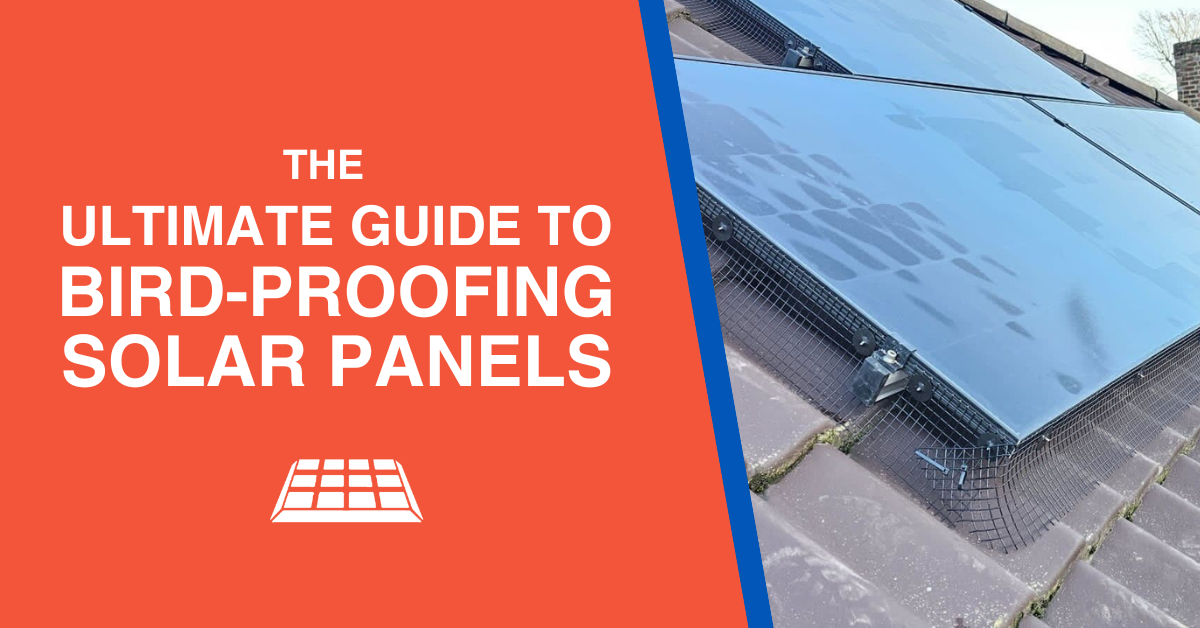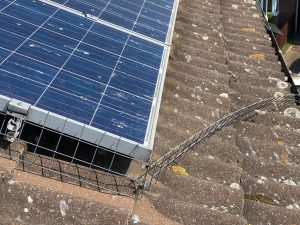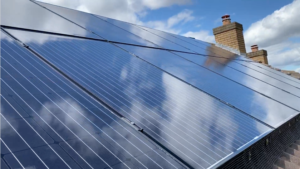
Ultimate Guide to Bird-Proofing Solar Panels
To you, solar panels are a valuable investment and power source. Unfortunately, for pigeons and other feathery vermin, they’re the perfect nesting place… and this is a recipe for headaches and hazards!
So, if you don’t bird-proof your solar panels, it could end up costing you a lot more money, time and energy later down the line.
Maybe you’re already suspicious because some pigeons have been keeping you up at night? Or perhaps you heard this can happen and are thinking “not under my roof” (or better, on top of it)?
Either way, we’ll show you how to fix or prevent this nightmare scenario by bird-proofing your solar panels ASAP.
Why do pigeons love nesting under solar panels?
Pigeons and other species love nesting under solar panels because:
- Birds are already drawn to roofs. After all, they’re an elevated location away from predators and closer to food sources
- Solar panels keep them sheltered from all kinds of weather conditions, like providing shade when it’s too hot and offering protection from rain and snow
- They’re also nice and warm
So, unfortunately, because they’re super cosy and safe, your solar panels are the ideal spot for a nest.
The types of birds and animals commonly found nesting under solar panels
Pigeons and jackdaws are the most common birds to nest under solar panels, but you might find other species too, like starlings and sparrows.
Potential risks and damages caused by birds under solar panels
When birds and vermin nest under your solar panels, they cause all kinds of problems, ranging from annoying to downright dangerous:
- Noise as they scurry around during the night, chirp and mate (and did you know that pigeons, in particular, can breed all year around?)
- Dirty droppings on the solar panels and the rest of your house and garden
Corrosion. Droppings aren’t just messy: they’re acidic, too. So, they can compromise the alluminium of your panels - Health risks, because bird droppings carry diseases like Cryptococcosis, Histoplasmosis, Psittacosis, E.coli and Salmonella (definitely not something you want around your family home!)
- Lower efficiency when they leave these droppings on the panels themselves. In fact, they could end up absorbing up to 30% less sunlight!
- Dislodging cables and chewing wires
- Long-term damage to your solar panels as a result
- Fire hazards due to how these vermin mess with wires but also because of the nests themselves (dry, combustible materials and warm solar panels? Not the safest match)
Bird-proofing your solar panels: prevention is better than cure
The best and cheapest option is to bird-proof your solar panels before pigeons turn them into their home.
Unfortunately, however, most solar panel companies don’t include pigeon-proofing with their installations. Some others only offer basic protection that isn’t good enough for the smallest birds.
So, if your solar panels haven’t got proper bird-proofing right now, let’s look at your best options.
Best bird-proofing solutions for solar panels
There’s a lot of misinformation out there, together with ‘quick fixes’ that don’t actually solve the problem in the long run.
So, regardless of whether you’re planning ahead or are already dealing with birds and vermin, here’s what you should consider.
Physical barriers
This type of bird-proofing will physically stop birds from (re)entering the area underneath your solar panels.
Mesh barriers
Mesh bird-proofing like PanelProof is the most common and effective option.
Pros:
- Effectiveness – Thanks to their design, mesh barriers are impeccable at keeping pigeons away from the underside of solar panels. This is because they cover their entire perimeter, and the mesh consists of very small gaps
- Discreet appearance – Mesh barriers are subtle and designed to blend in with the actual solar panels. So, they won’t ruin your building’s aesthetics
- Durability – Mesh barriers like PanelProof are robust, resistant and rust-proof. They’re made to withstand all kinds of weather conditions, and they’ll usually last for the entire lifespan of your solar panels
- Non-invasive – They keep birds and vermin away without harming them. So, they’re a more humane solution, especially when compared to certain spikes and chemical repellents
Cons:
- Installation complexity – You can buy mesh-proofing for your solar panels, but it can be more complex to install compared to other methods. So, you might require professional assistance
- Cost – Depending on their quality and design, mesh barriers can be more expensive than other bird deterrents. You might also have to factor in the cost of professional installation
Spikes
These are similar to the spikes you’ve probably already seen on roofs, buildings and pipes.
Pros:
- Easy installation – Bird-proof spikes are relatively easy to fit
- Effective against large birds – They can be a good deterrent for larger species, which would struggle to fit through them and make a nest under your solar panels
- Fairly low maintenance – Once they’re installed, most spikes don’t require any more effort (although, if they include upwards spikes, you might have to clean them regularly to avoid debris accumulation)
Cons:
- Limited effectiveness – Spikes are only really helpful for large birds. Smaller ones like pigeons will still find their way through them and underneath your solar panels
- Aesthetic concerns – Some spikes can be visually intrusive and unappealing. So, they might ruin the appearance of your roof and overall house
- Potential for injury – Some spikes can actually harm birds and other wildlife (that’s why, at Pigeon Proofing Solar Panels, we only use bird spikes that were endorsed by the Royal Society for the Protection of Birds). If you’re not careful, you could also injure yourself when fitting them
Angled sheeting
Rather than adding bird-proofing, some people prefer angling their solar panels to create a sliding surface.
Pros:
- Simple concept – You wouldn’t need to buy separate barriers or bird-proofing solutions. You’d create an angled surface that makes it harder for birds to land or nest on them
- Effective against larger birds – Angled sheetings can be a good deterrent for the biggest ones
Cons:
- Limited effectiveness – Smaller birds can easily cling to your angled sheets and nest there
- Aesthetic concerns – This change can alter the appearance of your entire solar panel setup and roof area
- Installation complexity – Poor installation can lead to reduced efficacy or even dangers. So, if opting for angled sheeting, you should definitely invest in professional help (which will also bring your costs up)
Overall, each bird-proofing method has some pros and cons.
However, mesh barriers tend to be the best and most effective solution: they’re safe, durable, discreet and work against all types of vermin – not just the biggest birds.
If you’re still on the fence, we can recommend the best option in your specific situation (start by telling us all about it when requesting a free quote).
Finally, you might have heard about other types of bird deterrents, too. Let’s cover them so that you don’t waste your time and money on these popular but problematic alternatives!
What about visual and auditory deterrents?
Visual and auditory deterrents (like reflective tape, decoy predators and ultrasonic devices) are often used as a bird-proofing alternative.
However, they’re not that effective at stopping birds from nesting under solar panels.
This is because they might startle them initially, but birds are quick to adapt and realise there’s no actual danger.
For example, take ultrasonic devices emitting frequencies that are meant to be unpleasant for birds. Scientific studies haven’t actually shown consistent effectiveness. Also, some of them only work for certain species, and either way, most birds tend to adapt to these sounds eventually.
Does reflective tape work?
Reflective tape isn’t a long-term solution to bird-proof your solar panels. Birds can easily adjust to it once they realise there’s no real threat.
What about chemical repellents?
Chemical repellents are a temporary bird-proofing solution at best. This is because their effectiveness decreases as the chemicals wear off, and birds can get used to them after a while.
On top of that, there are many concerns around the safety and environmental impact of using chemical deterrents.
Wouldn’t it be counterintuitive to invest in an eco-friendly alternative like solar panels and then add chemicals that are bad for the environment?
Let’s bird-proof your solar panels
Your solar panels were a wise investment. Now, to make the most of it while avoiding additional costs and hazards, it’s time to bird-proof them properly.
While there are different options, mesh barriers are the most effective type of solar panel proofing in most cases. That’s why, at Pigeon Proofing Solar Panels, we use PanelProof.
For the best results, let us take care of your mesh proofing with an all-inclusive package. If you already have some nests up there, we’ll also remove them for you – together with dead birds and debris.
So, contact us today to future-proof and bird-proof your valuable solar panels.
<- Back to blog


